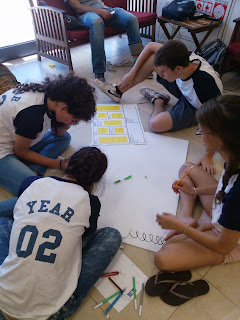Sights to see
Unfortunately, we were in Milan on a Sunday afternoon, Monday, and Tuesday morning. This meant that, like many respectable museums, many fantastic museums in Milan were closed on Monday. As a result, we did not get a chance to see the famous Triennale Design Museum or the La Scala Opera House Museum. However, we did get a chance to see:
- The Duomo cathedral of Milan - you can climb on the roof! How many cathedrals can you climb on the roof of? It's a cool Gothic-style cathedral right in the center of town.
- Galleria Vittorio Emanuelle II - a large covered "market", for lack of a better word. Cool designs to walk around through.
- Castello Sforzesco - cool old castle with fantastic park grounds you can walk around in, often filled with live music
Apparently to see The Last Supper you need to reserve your tickets months in advance, which we did not do. In either case, it costs on the order of 60 euros for 15 minutes of walking up to the fresco. I mean, it's famous art, but we couldn't justify 60 euros for 15 minutes worth of culture... it was probably too crowded anyway.
Eat with the locals!
While we were traveling, we made it a point to look up some particularly-recommended restaurants or eateries for cheap. One dinner in Milan we ended up with the most delicious dinner and wine we'd had in our entire stay in Italy. Unfortunately, I've seem to lost all record of it's address, so I'll never find it again.
We walked from the apartment we were staying to a small eatery that we nearly missed when we walked by it - it was literally a hole in the wall. We walk in to see three tables and a single deli-counter with meats and cheeses. A pleasant woman behind the counter seated us, and we proceeded to discuss what we were going to eat in a mix of Spanish and Italian (I don't speak Italian, she doesn't speak English - Spanish is a good compromise). We got a mixed plate of cheeses and meats to try, along with infinite bread. You might think that dinner on cheese, bread, and meats is not satisfying, but the cheese (goat, milk, sheep) was so rich and thick that it, combined with the cured, marinated, and salted dried meats was more than enough to satisfy us for a dinner.
We wanted to get some quality wine, too (since we didn't get to do any wine tasting while we were in Italy), so the woman spent some time explaining the 10 different kinds of wine that would go well with our meal. We settle, of course, on her favorite. What we didn't realize she did was put the bottle of wine right next to our table during dinner, so we ended up drinking the entire bottle along with our collection of fantastic local meats and cheeses, making that bottle of wine the most expensive bottle of wine we'd ever bought and drank - around 20 euros. Maybe Robin remembers the kind of wine we got, because I sure don't.
Just don't get covered in dirt
We found a place to stay from Airbnb and really had only one option. Our search parameters included (1) an awesome host and (2) close to all the sights. Turns out, we chose exactly right.
The room we rented was the spare bedroom of a Milan resident who lived exactly in the center of the city, maximum 20 minutes walk to all the central locations in Milan. Our host was Saeed, an Iranian man who was living in Milan studying industrial engineering and design in the polytechnic university in Milan. He was fun to talk to and gave us some amazing restaurant and bar suggestions. The apartment was on the second floor of a 3-story apartment building surrounding an inner courtyard. The spare room had two windows - one facing into the inner courtyard and the second facing out on the street. Because it was around 100 degrees Farenheit our first night in Milan, we opened all the windows and slept on top of the sheets, taking advantage of the cross-breeze. We were so tired from traveling the day before and being in the heat all day that we slept like logs.
The second night was cooler, so it was pleasant to keep the windows open. But we forgot that we were (1) in the center of town and (2) that it was supposed to be garbage collecting day the next morning. The good part was that the window next to my side of the bed was a strand of ivy that meant that with the window open the neighbors couldn't peer into the room.
Around 5am, the wind picked up, flinging pieces of dirt across me and Robin from the hanging ivy below. No problem. Close the window, clear off the dirt, go back to sleep. Wrong! Around 6:30am the garbage collector and recycling trucks appeared. First came the glass container - CRASH, BOOM, DING. Silence. CRASH BOOM DING. Ok, no problem, 20 minutes later it stops and we go back to sleep. But then the worst way to be woken from sleep comes again - the garbage truck. The garbage containers holding organic waste were picked up by the truck, releasing the strongest, most intense odor of compost right below our window. The smell seeped through the closed window, attacking our noses with it's awful smell. At this point I start laughing hysterically at the various ways we'd been woken up that morning, so we had a good giggle while the garbage truck did it's thing and went back to sleep before breakfast. Just goes to show, you never know how you can get woken up in a foreign country.








